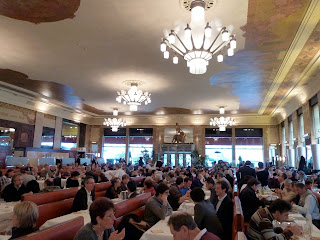The site has been inhabited since prehistoric times, but its current attraction is a picturesque setting and an impressive collection of very old structures. Included are Renaissance houses, a church dating from the 15th to the 19th centuries with lovely stained glass, vestiges of the town’s wall, and the castle keep from the 11th century.
Situated on a hillside above a small river, the town with the church and surrounding structures presents an impressive site.
 |
| Skyline of the Church and related Structures |
Except for the locals, we mostly had the town to ourselves as we wandered the narrow, steep streets, looking at all the sites. Many of the streets were undergoing repair during the off season, so we often had to pick our way around barricades and obstacles, but there was nothing that presented a real problem.
 |
| The 11th Century Keep or Donjon |
 |
| The Plaque on the Remnant of the town wall explaining that it was built in 1060 |
The only real downside was that our lunch in a local brasserie was not as great as we have come to expect – only good, and not spectacular. However, this was more than compensated by our discovery of the shop of Jean-Christophe Bouche, the local chocolatier. His products were true works of art. The place reminded us very much of the French film ‘Chocolat’, with Juliet Binoche and Johnny Depp. [If you’ve never seen it, you should] Madam in the shop was very ‘gentil et agreeable’, and could have been in the movie. The chocolats, of course, were merveilleuse!
 |
| Church from the other side of town |
| Inside of the church |
| One of the Stained Glass Windows |
As a final note, while in town we discovered a Mystery! It seems that one of the town's most prominent native sons, although not mentioned as such on the town's website, was Pierre-Marie Durand, who died at 89 in 1951, leaving the town 150 million francs. It seems he made his money in the pre-war years in the electrical utility business in southern France. After the war he somehow ran afoul of the law by moving money out of the country. He avoided significant jail time by dint of his involvement with the Resistance and by agreeing to forfeit 500 million francs to the government. We have researched and cannot find reliable details on this. Our guess is that France had strict post-war currency control laws and M. Durand feared that a communist takeover would result in the loss of all his assets. Therefore, he moved a portion out of the country.
There is a memorial to the town's benefactor, with a picture of Anna in front of it.
 |
| Anna and M. Durand |























